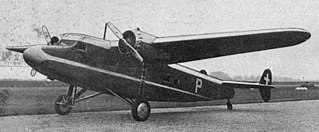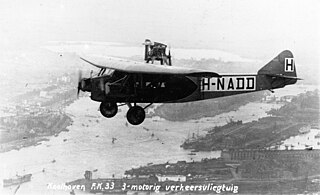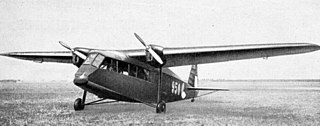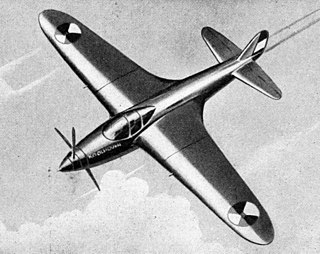
The Koolhoven F.K.58 was a single engine, interceptor-fighter aircraft designed and mainly manufactured by N V Koolhoven in the Netherlands under contract by France. Intended for Armée de l'Air use, the F.K.58 saw limited service in the Battle of France.

The Armstrong Whitworth F.K.3 was a British two-seat general-purpose biplane built by Armstrong Whitworth Aircraft during the First World War. By the end of the war it was considered obsolete for combat.

Koolhoven F.K.52 was a Dutch-designed, two-seat reconnaissance-fighter biplane, which was developed in the 1930s by Koolhoven. The aircraft was equipped with an enclosed cockpit and single-strut landing gear. Only six aircraft were produced. The aircraft saw some service in the Finnish Air Force.

The Armstrong Whitworth F.K.10 was a British two-seat quadruplane fighter aircraft built by Armstrong Whitworth during the First World War. While it was ordered in small numbers for the Royal Flying Corps and Royal Naval Air Service, it was not used operationally. It is one of the few quadruplane aircraft to reach production.

The BAT F.K.23 Bantam was a British single-seat fighter biplane produced by British Aerial Transport Company Limited of London during World War I.

The BAT F.K.24 Baboon was a British two-seat training biplane produced by British Aerial Transport Company Limited of London during World War I.

The BAT F.K.26 was a British single-engined four-passenger biplane transport aircraft produced by British Aerial Transport Company Limited of London at the end of World War I.

The Koolhoven F.K.51 was a 1930s Dutch two-seat basic training biplane built by the Koolhoven Company.

The Koolhoven F.K.50 was a 1930s Dutch eight-passenger light transport monoplane designed and built by Koolhoven.
The Koolhoven F.K.42 was a parasol-wing, two-seat training monoplane manufactured by Koolhoven in the Netherlands. Only one was built.

The Koolhoven F.K.46 was a 1930s Dutch training biplane designed and built by Koolhoven.

The NVI F.K.33 was an airliner built in the Netherlands in 1925 for use by KLM for night flying.
The Koolhoven F.K.40 was a small airliner built in the Netherlands in 1928 for KLM Royal Dutch Airlines. It was a conventional high-wing cantilever monoplane powered by a single engine in the nose. The fuselage was made of welded steel tube construction with a wooden wing skinned in plywood and held in place by four bolts to facilitate removal. The cabin was spacious for an aircraft of its size, and was intended to be readily reconfigured for passengers, mail, or freight. Although up to six seats could be fitted, the only F.K.40 built flew with four.

The Koolhoven F.K.48 was an airliner built in the Netherlands in 1934 for KLM.

The Koolhoven F.K.49 was a photographic survey aircraft built in the Netherlands in 1935.

The Koolhoven F.K.53 Junior was a small sport aircraft built in the Netherlands in 1936. It was a low-wing cantilever monoplane of conventional design, with tandem seating for two under a long canopy. The wings had a gull shape and carried the main units of the tailwheel undercarriage. Two examples were built, and both destroyed in the German bombing of Waalhaven in May 1940. The first machine built had been purchased by the Dutch national flying school.

The Koolhoven F.K.55 was a Dutch fighter prototype of the 1930s, which did not progress beyond the prototype stage.

The BAT F.K.25 Basilisk was a prototype British fighter aircraft of the First World War. A single engined biplane intended to meet a requirement to replace the Sopwith Snipe, the Basilisk was unsuccessful, only three being built.
The JPM 01 Médoc is a French amateur-built aircraft that was designed by Jean-Pierre Marie in 1987 and produced by Avions Jean-Pierre Marie (JPM) of Le Mesnil-Esnard. The aircraft is supplied as plans for amateur construction.
The Stern ST 87 Vega is a French homebuilt aircraft that was designed by Rene Stern, first flying in July 1992. The aircraft is supplied in the form of plans for amateur construction.
















